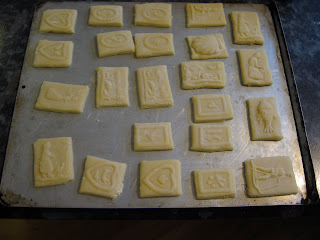 With our oven repaired, I've started on making traditional German Christmas cookies, which is basically the only German food we make. Springerle have a distinctive taste that can take some getting used to (I like them much more now than I did as a kid, and they aren't for anyone who hates black licorice). I love the taste, but they are a family favourite because they are beautiful, impressed with hand-carved molds featuring German folk art. The molds are very hard to find outside of Germany (although I'm sure they can be found online) and every year my dad and uncle take turns with them, and my dad mails some of the finished product to his sister and my brother, both living far away. It wouldn't be Christmas without them, and that's why I've taken the pains to make them starting December 27th (it is quite the process). This is my grandmother's recipe.
With our oven repaired, I've started on making traditional German Christmas cookies, which is basically the only German food we make. Springerle have a distinctive taste that can take some getting used to (I like them much more now than I did as a kid, and they aren't for anyone who hates black licorice). I love the taste, but they are a family favourite because they are beautiful, impressed with hand-carved molds featuring German folk art. The molds are very hard to find outside of Germany (although I'm sure they can be found online) and every year my dad and uncle take turns with them, and my dad mails some of the finished product to his sister and my brother, both living far away. It wouldn't be Christmas without them, and that's why I've taken the pains to make them starting December 27th (it is quite the process). This is my grandmother's recipe.Springerle (makes about 30 cookies, depending on size of molds)
Notes: These anise flavoured cookies, Springerle, have been described by some misinformed cook-book writers as beautiful but "hard and tasteless". Follow this recipe, store carefully, and you will see how wrong they are. For very fine sugar, grind granulated sugar in a blender at high speed to convert to fine sugar-1 cup at a time about 1 minute works well, and costs less than buying it in the store, if they carry it at all.
 Springerle molds come in the form of carved rolling pins and as flat rectangles. Keep these out of water. Clean with a stiff brush, pick out dried dough with the sharp tip of a bamboo skewer. It seems to help sometimes if the molds are cold (put in freezer between uses). Anise oil can be obtained from health food stores and from some pharmacies. It gives a much clearer and nicer flavour than anise extract. Anise seeds can be sprinkled on the baking sheet before putting the cookies on for added texture and a bit of taste.
Springerle molds come in the form of carved rolling pins and as flat rectangles. Keep these out of water. Clean with a stiff brush, pick out dried dough with the sharp tip of a bamboo skewer. It seems to help sometimes if the molds are cold (put in freezer between uses). Anise oil can be obtained from health food stores and from some pharmacies. It gives a much clearer and nicer flavour than anise extract. Anise seeds can be sprinkled on the baking sheet before putting the cookies on for added texture and a bit of taste.- 6 large eggs, room temperature
- 3 cups/680g very fine sugar (aka fruit sugar, VeriFine™, NOT confectioners sugar)
- 3/8 tsp salt
- 3/8 tsp anise oil (3/4 tsp if using anise extract)
- 1 large lemon, grated rind of
- 6 cups/675g sifted flour, all purpose white (you can just whisk it for a while in a large bowl if you don't own a sifter or are not inclined to use one)
- 3 tsp baking powder

Remeasure the sifted flour and and sift together with baking powder (or if you are whisking, not sifting, just whisk together). Fold/mix it into the egg/sugar mix with a wooden spoon (never electric mixer). This will make a very tender dough. Cover dough tightly with plastic wrap and refrigerate overnight.

Roll out about half the recipe, 3/8" (10 mm) thick on a floured counter. Press or roll the traditional German carved wooden Springerle molds into the dough deeply enough to make a clear impression. The molds should be lightly dusted with flour. Cut around the impression with a sharp floured knife, and transfer the cookies to a buttered baking sheet. Leave an inch between cookies.


Set aside in a warm place for 8-12 hours (overnight) for the patterns to air-dry thoroughly, so the baking won't destroy them.


Bake at 300˚ (150˚ C) for 15-20 minutes (until very light yellow, NOT browned at all). Larger cookies may need slightly more time. Remove immediately from the cookie sheets to racks for cooling.

To keep them from drying out and becoming hard, store the cookies in an air-tight container or zip-lock plastic bag which should be kept closed except when taking cookies out to eat. An apple slice wrapped loosely in foil can be included to help maintain humidity. Store for at least one week.

















